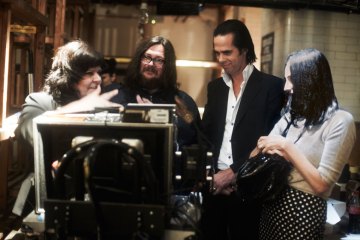Nick Cave takes a ride with Kylie Minogue in "20,000 Days on Earth."
Premiering January 20 at the Sundance Film Festival in Park City, Utah, 20,000 Days on Earth is a documentary-fiction hybrid feature portraying a fictionalized day in the life of Nick Cave, the Australian bandleader of Nick Cave & the Bad Seeds. Deftly balancing the ordinary and the uncanny, the film’s ostensibly 24-hour span comprises the entire lifecycle of Cave’s 2013 album Push the Sky Away from writing through recording and performing.
Artists Iain Forsyth and Jane Pollard, here making their feature directorial debut, have previously queried the contradictions and mythmaking structures of rock music through film, video, sound and installation. Having already collaborated with Cave on audio projects and music videos, they turned their cameras on Push the Sky Away’s recording sessions with the assumption they might contribute some sort of promotional material for the album’s release. Responding to a biographical calculation from one of Cave’s journals, the artists’ began to develop a fictional narrative structure around their footage.
Amid sessions, Cave traverses the landscape of his adopted U.K. home of Brighton in his Jaguar XJ. Appearing in the back seat as if apparitions, friends such as Kylie Minogue, Ray Winstone and former Bad Seed Blixa Bargeld engage Cave in pensive conversation, provoking revelatory and amusing exchanges that belie Cave’s history as a touchy interview subject given to personal distortions.
And yet these unguarded moments happen within a highly constructed visual vocabulary. As Pollard explains, “We were always looking for a way to make something special happen in the room, then we began to develop strategies for how we could capture this on camera. Often for us this means scripting the camera and not the performer.”
One key sequences takes place in the Nick Cave Archive, fictitiously transposed to Brighton from its home in Melbourne. Photographs of a 1981 show by Cave’s influential post-punk band the Birthday Party are projected on to a concrete wall, each sequentially detailing the trajectory of a fan’s urine spilling onto the stage. Cave speaks to the advancement of images as each frame from this fleeting moment of chaos presents a new avenue of introspection, historical reminiscence and personal history.
Deconstruction of such moments — moments whose incorporation into popular mythology illustrates the mutual exchange between anarchic spontaneity and the often rehearsed structures of rock and roll — is Forsyth and Pollard’s forte. Among their body of work is File Under Sacred Music (2003), which recreates a widely-bootlegged video of a performance by the Cramps at Napa State Mental Asylum, down to the minutiae of camera movements and damaged-video aesthetic. Within this carefully supervised context, genuine reactions occur — a response to what Pollard calls “the magical contradiction on which all rock and roll is founded: a band can play the same set for 100 nights in a row … and every night the room is full of people having a unique, genuine, and occasionally life-changing experience.”

Nick Cave on the set of “20,000 Days on Earth” with Jane Pollard (left) and Iain Forsyth.
It’s little surprise, then, that Cave’s own history of images is carefully woven throughout the story, most notably in archival live footage the artists draw on during the film’s climactic performance of Push the Sky Away’s “Jubilee Street” at the Sydney Opera House.
“It seemed to use that in the climax of that performance, in that mass of summoned energy, there was the possibility for the past to break through the surface of the present,” Forsyth said. “And though these cracks, the mythology reveals itself.”
Jon Dieringer is a filmmaker, independent curator and the editor and publisher of Screen Slate, a daily online resource for listings and commentary of New York City repertory film and independent media.


